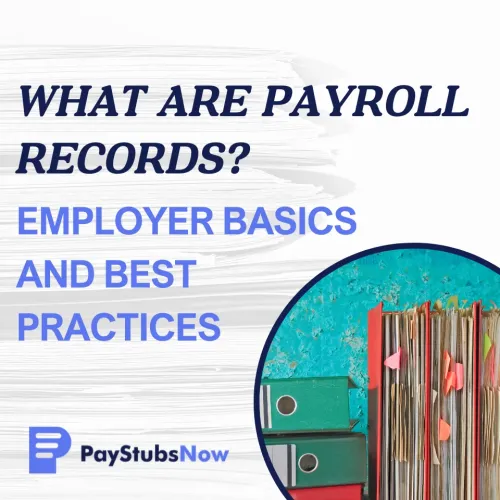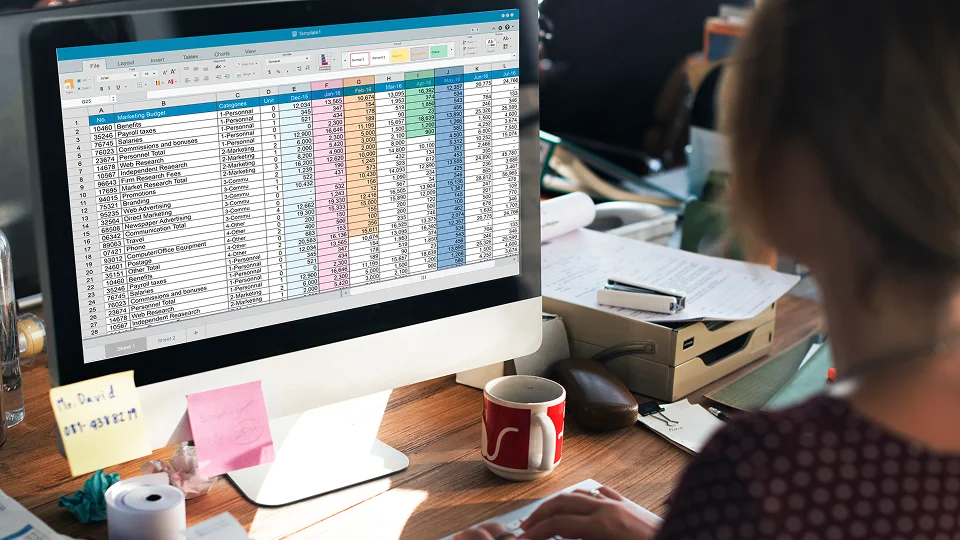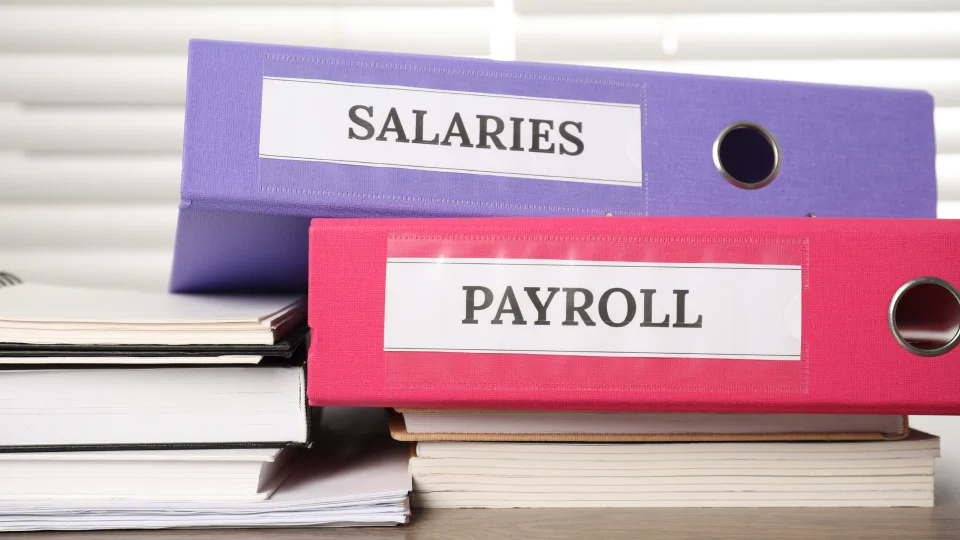


Accurate payroll records aren’t just paperwork. They’re a legal requirement and a key part of running a compliant, organized business. From tracking employee hours to documenting tax withholdings, these records ensure you’re meeting obligations and staying audit-ready at all times.
In this blog, we'll explore the essential components of payroll records, why maintaining them is crucial for employers, and the laws that govern payroll practices. You'll also discover how long to retain these records and best practices to ensure they're stored correctly.
And for modern solutions, you'll learn how Paystubsnow can be your go-to tool for simplifying payroll recordkeeping.
Payroll records are official documents that track employee compensation and related payroll details. Employers use them to document wages, hours worked, tax withholdings, and benefits for each employee.
Key components of payroll records include:
Keeping accurate payroll records is essential for tax compliance, labor law adherence, and smooth payroll operations.

Let's explore the essential components of payroll documents to ensure that all aspects of compensation and compliance are precisely tracked and recorded.
Payroll documents begin with essential employee identification details such as full name, employee ID, Social Security number, job title, and department. This information ensures accurate tracking and prevents mix-ups between workers. It also links payroll employment records to the correct personnel files, allowing HR and accounting departments to maintain consistent and compliant records.
Recording hours worked is critical for calculating pay accurately, especially for hourly employees. This section typically includes regular hours, overtime, and paid time off. Time tracking systems or manual timesheets feed this data into payroll systems. Properly recorded work hours help prevent wage disputes and ensure compliance with labor laws and overtime regulations.
This section outlines the employee's compensation structure, whether regular hourly pay rate, salaried, or equal employment opportunity commission-based. It includes gross pay before deductions and often breaks down pay by type—regular wages, overtime, bonuses, or incentives, per the collective bargaining agreement. Accurate wage documentation is essential for budgeting, tax reporting, and ensuring employees are paid.
Payroll documents include detailed tax information to ensure compliance with federal, state, and local tax laws. This typically covers withholdings such as federal income tax, Social Security, Medicare taxes , and applicable state or city taxes. Employer contributions may also be recorded here. Accurate tax documentation is critical for W-2 preparation and Internal Revenue Service reporting.
Beyond wage rate tables and employment taxes, payroll documents may contain other financial data like benefits contributions, retirement plan deductions, garnishments, and reimbursements. This part ensures full transparency of all financial transactions related to an employee's paycheck. It also aids in audits, helps resolve pay discrepancies, and supports financial planning for the employer and employee.
 With the key components noted, let's understand why detailed payroll records are crucial in managing your workforce efficiently.
With the key components noted, let's understand why detailed payroll records are crucial in managing your workforce efficiently.
Navigating payroll regulations requires a keen understanding of federal laws. These regulations ensure fair labor standards and secure tax compliance for your business and employees. They include:
The FLSA sets rules on minimum wage, overtime pay, and child labor. Employers must comply with these standards to ensure fair compensation and lawful working conditions for everyone.
The IRC governs how employers withhold, report, and deposit federal income taxes. It outlines essential tax obligations businesses must meet to comply with federal payroll regulations.
These laws require employers and employees to contribute to Social Security and Medicare. They ensure workers receive retirement, disability, and medical benefits from tax deductions.
While federal laws set baseline standards, some states impose more stringent regulations, such as longer retention periods or additional purchase records like state tax withholding certificates. Failing to comply with these state-specific nuances might lead to fines. Therefore, staying informed and compliant with federal and state requirements is essential for effective payroll management.
By maintaining accurate records, you gain a clearer insight into your company's financial health, helping to aid budgeting and strategic planning. Regularly reviewing your payroll data allows for efficient tracking of labor costs, identifying financial trends, and ensuring that resources are optimally allocated.
Being ready for an IRS audit isn't just about having stacks of paperwork. It's about maintaining clear, organized payroll records that comply with guidelines. These documents must efficiently reflect every financial transaction related to employee wages, benefits, and taxes. Integrating systems like Paystubsnow allows you to generate precise records on demand, minimizing stress during audits.
When employees feel confident that their wages and benefits are accurately recorded and dispensed on time, trust is cultivated, enhancing morale and productivity. Ensuring transparency in financial matters, offering easy access to personal payroll information, and addressing discrepancies promptly portray a company as reliable and employee-focused.
 While some may think that keeping payroll records is just good practice, it’s actually the law. Let's examine how long you should hold onto these vital documents to ensure compliance and avoid potential headaches:
While some may think that keeping payroll records is just good practice, it’s actually the law. Let's examine how long you should hold onto these vital documents to ensure compliance and avoid potential headaches:
 Let's now move on to discovering effective methods to organize and manage these crucial documents effortlessly.
Let's now move on to discovering effective methods to organize and manage these crucial documents effortlessly.
Maintain a clear system for categorizing payroll documents by employee, the pay period covered, and record type. Use folders or digital labels to streamline access and reduce confusion. Organized records help prevent compliance issues and simplify audits.
Protect sensitive payroll data from theft or unauthorized access. Use locked cabinets for physical files, encrypted servers, or password-protected digital payroll record storage platforms. Always restrict access to authorized personnel only.
Choose user-friendly payroll software to automate calculations, track hours, and generate reports. The right platform reduces manual errors, saves time, and keeps records consistent and easy to update or review.
Stay compliant with federal and state laws by knowing how long to keep payroll records. Generally, documents are retained for at least three to seven years, depending on the record type and jurisdictional rules.
Give employees access to their payroll information, such as pay stubs and tax documents. Transparency builds trust and allows workers to verify their records when needed, whether through a portal or by request.
When records end their retention period, dispose of them securely. Shred physical documents and permanently delete digital files. Improper disposal can lead to data breaches and legal risks.
Juggling numerous payroll documents can be challenging for any employer. Discover how Paystubsnow streamlines this process, offering a hassle-free solution for generating and managing payroll records:
We've given you the lowdown on payroll records, from their components to why they matter to the best practices for payroll record keeping. Managing payroll records shouldn't be challenging with Paystubsnow; you can easily and precisely handle your payroll documentation.
Our platform offers professional pay stubs tailored to your business needs, ensuring compliant recordkeeping that meets all necessary regulations. Our intuitive system saves time and reduces errors—no more scrambling for last-minute document preparations.
Beyond pay stubs, our solutions extend to generating detailed payroll summaries, employee tax documents, and even W-2s on demand, all optimized for your convenience. Say goodbye to clutter and hello to streamlined, digital recordkeeping.
With Paystubsnow, you have the tools and support to maintain impeccable payroll records, thus enhancing your business operations and employee satisfaction. Why wait any longer?
Take control of your payroll records with Paystubsnow today!